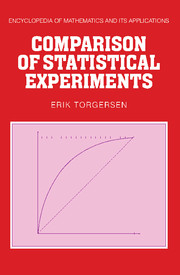Book contents
- Frontmatter
- Contents
- Preface
- Acknowledgments
- 1 Statistical experiments within the measure theoretical framework
- 2 Convexity
- 3 Two-person, zero-sum games
- 4 Statistical decision problems
- 5 Vector lattices
- 6 Deficiencies
- 7 Equivalence, representations and functionals of experiments
- 8 Comparison of linear models
- 9 Majorization and approximate majorization
- 10 Complements: Further examples, problems and comments
- List of symbols
- Author index
- Additional references
- Subject index
6 - Deficiencies
Published online by Cambridge University Press: 05 May 2013
- Frontmatter
- Contents
- Preface
- Acknowledgments
- 1 Statistical experiments within the measure theoretical framework
- 2 Convexity
- 3 Two-person, zero-sum games
- 4 Statistical decision problems
- 5 Vector lattices
- 6 Deficiencies
- 7 Equivalence, representations and functionals of experiments
- 8 Comparison of linear models
- 9 Majorization and approximate majorization
- 10 Complements: Further examples, problems and comments
- List of symbols
- Author index
- Additional references
- Subject index
Summary
Introduction
The single most important concept in this work is the concept of a deficiency
Let ℰ and ℱ be two experiments having the same parameter set Θ. Then we shall say that ℰ is at least as informative as ℱ, if to any decision problem and any decision rule in ℱ there is a decision rule in ℰ which is at most as risky for any θ in Θ.
In this way we arrive at the partial ordering ‘being at least as informative as’ for experiments having the same parameter set Θ. The concept of sufficiency corresponds to the case where ℰ is a subexperiment of ℱ.
With this kind of a definition it is to be expected that the ordering is not total. In fact in general we may expect that two experiments having the same parameter set Θ are not comparable with respect to this ordering. Thus we are led to the following generalization of the fundamental question: How much do we lose, under the worst possible circumstances, by using ℰ instead of ℱ?
As we shall see, an answer to this problem may be given by a non-negative number; the deficiency of ℰ with respect to ℱ.
Closely associated with the notion of deficiency is a distance for experiments or, equivalently, for the (undefined) amounts of information carried by the experiments.
Finally we may restrict our attention to certain types of decision problems. This leads to deficiencies and distances relative to the relevant type of decision problems.
Information
- Type
- Chapter
- Information
- Comparison of Statistical Experiments , pp. 222 - 328Publisher: Cambridge University PressPrint publication year: 1991
